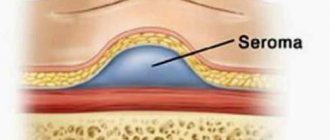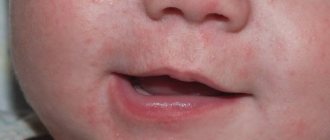Most likely, not everyone has heard about polyps in the human nose. Although this diagnosis occurs in four percent of the world's population. Nasal polyps are benign formations that appear due to the proliferation of the mucous membrane of the nose and paranasal sinuses.
A person does not immediately notice the appearance of polyps: when a polyp first appears in the nasal cavity, it does not manifest itself in any way, so a person does not see any reason to contact an otolaryngologist. Problems with the nasal cavity appear when the tumor increases in size, and the sick person notices typical signs of polyp formation: constant congestion and mucous discharge from the nose. People with the disease think that they are faced with a common runny nose; but the classical use of treatment with vasoconstrictor nasal drops does not bring any effect. And living with signs of congestion is very uncomfortable. It is this unpleasant symptom that forces a person to consult an ENT doctor for treatment.
Unfortunately, most often this does not happen at the initial stage of the disease, when conservative treatment can still be carried out. In most cases, the patient sees an otolaryngologist when only surgical treatment is possible.
The occurrence of a neoplasm is associated not only with the manifestation of unpleasant symptoms: the appearance of polyps in the nasal cavity and sinuses is associated with the occurrence of certain health problems.
It is not surprising that when visiting an ENT doctor, a person has many questions related to the occurrence of polyps. What do nasal polyps look like? What are the causes of neoplasms and their typical signs? What is polyposis? What causes polyposis? The causes, symptoms and treatment of polyps in the human nose and sinuses is the topic of our new article.
Nasal hemangioma and other benign tumors of the nose
Benign nasal tumors are formed from various tissues present in the nose and paranasal sinuses. Hemangioma is a benign tumor that most often develops in the first days of a child’s life and actively grows in the first six months of his life. After the child is one year old, the tumor begins to involute; most of the hemangiomas disappear by the age of seven, the rest by the age of twelve. More often, hemangiomas form in girls. The cause of the disease is a disturbance in the development of blood vessels in the embryonic period. Nasal hemangioma can grow deep into the skin, tissues of the organ and to the sides, destroy tissues, provoke bleeding, and disrupt the functions of the organ.
Nasal fibroma is a benign formation that can spread to the orbit. Nasal fibroma is rare, characterized by active growth and quickly grows into the orbit and paranasal sinuses. The tumor causes nosebleeds and nasal congestion. Fibroma that has grown into the orbit and nasal sinuses causes various complications: constant lacrimation, decreased visual acuity, exophthalmos, and can cause deformation of the skull bones. Fibroids rarely develop in the paranasal sinuses, most often developing in the maxillary sinus.
Adenomas in the nose can be true adenomas, a papilloma-like tumor, or a malignant destructive adenoma. Adenomas do not produce secretions, despite the fact that the tumor contains glandular epithelium. Adenomas in the nose are rare and are characterized by nosebleeds, nasal congestion, and can lead to the development of exophthalmos, purulent dacryocystitis and other complications.
Benign neoplasms of the nose are osteoma, chondroma, angioma, papilloma, chordoma, lipoma, myxoma, bleeding polyp, ganglioneuroma, dermoid cyst and other neoplasms. Tumors are formed during intrauterine development of the fetus with a negative impact on the woman’s body during pregnancy. They can appear in chronic diseases of the nasopharynx; the appearance of tumors is influenced by poor environmental conditions, injuries, and infections.
Causes
There are actually many reasons why polyps appear in the nasal cavity. Such diseases in medicine are called polyetiological (from “poly” - “many” and “etiology” - “cause”). That is, it is a disease, the occurrence of which can be associated with many reasons. What exactly is the cause of the disease in a person in each specific case can only be determined by a thorough examination.
Possible reasons include:
- frequent rhinitis;
- frequent colds;
- reduced immunity;
- hereditary factor;
- entry of a foreign object into the nasal cavity;
- curved nasal septum, narrow nasal passages and other structural features of the nasal cavity that cause nasal breathing disorders;
- chronic diseases of the nasal cavity and sinuses (sinusitis, sinusitis);
- allergic rhinitis.
It is also believed that the occurrence of neoplasms can also be influenced by the following reasons (more precisely, not direct reasons, but provoking factors): asthma, unfavorable environmental conditions in the place of residence, genetic reasons, the presence of bad habits.
Due to the influence of one of these reasons, the mucous membrane of a person’s nose ceases to function adequately, grows, and outgrowths appear on it - polyps.
Cancer of the nose and paranasal sinuses: symptoms
A tumor in the nose develops in the maxillary sinus (maxillary sinus cancer), and cancer also affects the nasal cavity. Nasal cancer, the symptoms and signs of which become pronounced at a late stage, accounts for 1.5% of all cancers; men are more often affected. The reasons for the development of the disease are not fully known; most often, nasal cancer develops in workers of nickel production enterprises, woodworking and leather industries, in people who smoke and who often suffer from nasal infections. Symptoms and signs of nasal and sinus cancer vary. At the initial stage of development, the symptoms are similar to those of various diseases - rhinitis, sinusitis and other disorders.
Then the patient begins to experience headaches, discomfort, pain in the sinuses, and a change in sense of smell. The nose is constantly stuffy, mucous discharge from the nose bothers me. The pain can radiate to the upper jaw, temple, and a constant severe headache - such symptoms develop with cancer of the maxillary sinuses.
Cancer of the posterior external part of the maxillary sinus is manifested by difficulty while eating, difficulty opening the mouth - the cancer grows into the masticatory muscles. Cancer of the anterior lower part of the maxillary sinus often affects the hard palate and upper jaw, leading to tooth loss and the appearance of wounds on the gums. Cancer of the nose and paranasal sinuses can lead to displacement and loss of the eye, and facial deformation.
Squamous cell carcinoma is the most common type of cancer; adenoid cystic carcinoma, adenocarcinoma, poorly differentiated transitional cell carcinoma, olfactory esthesioneuroblastoma and melanoma are less common. Carcinoma of the nose is not as dangerous as cancer of the paranasal sinuses, which has a less favorable prognosis. If early stage cancer is detected on the nose, then the five-year survival rate of patients is more than 50%, for cancer of the paranasal sinuses it is no more than 25%. Sinosanal poorly differentiated carcinoma has an aggressive course - the tumor affects the paranasal sinuses and nose, and is characterized by the appearance of ulcers and a tendency to necrosis.
Cancer of the nose and paranasal sinuses has clinical manifestations depending on the location of the tumor. Often a tumor in the thickness of the alveolar process is mistaken for an inflammatory process. It manifests itself in growth after tooth extraction. It is very difficult to differentiate tumors from the upper internal sinus. A tumor of the upper outer part of the maxillary sinus can remain unrecognized for a long time and manifest clinical symptoms in the form of pain. A tumor that has grown into the orbital area is manifested by swelling of the lower eyelid. A tumor that affects the infratemporal fossa, pterygopalatine fossa leads to swelling of the eyelid, the development of chemosis with exophthalmos.
Reviews about removing warts on the head
After reading reviews about removing warts on the face, you will understand that only this option guarantees a 100% positive result. The likelihood of complications is below 0.01 percent. For comparison, when using nitrogen, the likelihood of complications and scars is about 2 percent.
And lastly, among our specialists there are cosmetologists, with whom it is also possible to conduct consultations. This is useful if there is a high risk of a postoperative scar. Although calling laser wart removal an operation is not entirely correct. This is a cosmetic procedure.
Nasopharyngeal cancer
With a tumor of the nasopharynx, the symptoms of the disease can be widespread and less common. Early manifestations of nasopharyngeal cancer are nasal congestion, a burning sensation in the throat, swollen lymph nodes, and ear congestion. The symptoms are similar to those of a cold. The tumor begins to progress rapidly and is manifested by the following symptoms: nosebleeds, hearing loss, sore throat, nasal congestion, frequent headaches, enlarged cervical lymph nodes, squint on one side, a feeling of numbness in the face, difficulty opening the mouth, non-healing in the nasopharynx. wounds.
Nasopharyngeal cancer is dangerous because the disease is asymptomatic in the early stages of development. Very often, the symptoms of cancer resemble the symptoms of colds. When oncology of the nasopharynx is detected, the symptoms most often indicate a late stage of cancer - an unpleasant putrid odor appears from the mouth, the patient feels an unpleasant odor that comes from the nasal sinuses, headaches are tormented, the vocal cords swell, the voice changes, the patient has difficulty swallowing, opening the mouth.
Nosebleeds are a constant concern, the body temperature periodically rises, tachycardia worries, speech becomes incoherent, strabismus and paralysis of the facial nerves may develop. Stage 4 nasopharyngeal cancer is characterized by general weakness, severe symptoms, severe pain in the nasopharynx, neck, and headaches.
Damage to the mucosa
A lump in the nose of a child or adult often looks like a simple pimple. Such unpleasant bumps on the inside of the nose are more sensitive than formations on other parts of the body. A painful bump inside the nose can appear as a result of inflammation of the hair follicles. Due to the humid environment inside the organ, various microorganisms, including pathogenic ones, are constantly present in it. They are the ones who can penetrate the follicle and begin rapid reproduction in it. As a result of this process, folliculitis begins - a large amount of pus accumulates in one place, which leads to the appearance of a pimple or bump inside the nose. You should know exactly what it is and what such formation looks like. You need to see a doctor or look at a photo of a bump in the nose of a child (adult).
Diagnostic measures
Treatment of a bump in the nose is prescribed exclusively by a professional after diagnosis and examination of the patient, while he takes into account the stage of development of the disease, the reasons for its appearance, as well as the features of the anatomical structure.
Diagnostic measures most often include an analysis of the patient’s complaints, a thorough examination of the nasal cavity using a rhinoscope or endoscope. The doctor may also refer the patient to other specialists or order additional tests and biopsies. Often, growths in the nose are identified immediately after the initial examination.
Main diagnostic methods:
- rhinoscopy;
- CT or MRI of the paranasal sinuses;
- radiography.
The cost of diagnostics will directly depend on the severity of the disease and its stage of development. An appointment and consultation with a doctor in Moscow will cost around 1000-2000 rubles. Complicated forms of examination can cost up to 6,000 rubles.
Drug treatment
There is no universal way to eliminate growths in the paranasal sinuses.
The treatment regimen for each individual case is established taking into account the patient’s physiology and the characteristics of the course of the disease. Expert opinion
Sakania Luiza Ruslanovna
Dermatovenerologist, cosmetologist, trichologist
Ask a Question
The goal of drug therapy is to prevent relapses of pathology, reduce growths, and stimulate the defense mechanism. Nasal polyps can be eliminated with medications.
Corticosteroids (Flixonase, Nazarel, Triamcinalone) - nasal sprays have anti-inflammatory, vasoconstrictor, antiallergic effects. They normalize breathing by reducing spasms in smooth muscle muscles.
Antihistamines (Citrine, Zodak, Fenistil) are antipruritic drugs that reduce the intensity of allergic manifestations. To increase the absorption of nasal agents, the nose should be irrigated with saline before instillation of the mucous membrane.
Additionally, rinsing of the nasal passages, compresses, and inhalations are performed.
Etiotropic therapy
Timely treatment and properly selected medications guarantee active regression of the disease with the lowest risk of recurrence. Treatment of growths is aimed at removing the infectious pathogen and destroying the neoplasm itself.
Antiviral (Verrukacid, Vartek) - reduce inflammation, increase the effect of necrosis of damaged tissues, and prevent the invasion of pathogenic microbes into the tissue part of the body.
Immunomodulatory (Oxolinic ointment) - the main substance is oxolinum, has an antiviral effect, favors the formation of barrier protection of the immune system.
Keratolytic (Collomac, Solcoseryl ointment) - used to destroy epithelial growths, warts, calluses, etc.
Surgical treatment
Modern medicine involves many different methods of excision of benign mucosal tumors; only in rare situations is traditional destruction performed.
Open surgery is undesirable for children due to changes in the integrity of the skin and complex and long postoperative regeneration.
There are several types of polyp removal.
Cryodestruction
Removal of the mucosal tumor is performed with liquid nitrogen. Through rapid freezing, papillomas are destroyed. This method is inexpensive and quite effective. Patients tolerate the procedure well; repeated measures are not required.
Laser elimination
Contactless method. The manipulation does not require any specific preparation or recovery period. Removal of growth in the nasal area is carried out by coagulation, evaporation of soft tissue.
The duration of the procedure is no more than 5 minutes. It is usually carried out once, but in rare situations it may be necessary to perform several steps.
Polypotomy
Common removal method. The growth is eliminated using a cutting loop (Lange hook). The positive thing is that the polyp can be removed the first time.
Endoscopy
This surgical intervention involves local anesthesia. A camera is inserted into the nose through the nostril for visual inspection. Through the monitor you can see the size and amount of growth.
At the time of removal, the most important areas remain untouched. After endoscopy, the scars are invisible.
Electrocoagulation
The essence is thermal damage to tissues by electric current. All layers of tissue are affected, and therefore the blood quickly clots, preventing the possibility of infection and nasal bleeding.
Removal using a shaver
Observation is carried out on a computer monitor, and the self-removal of the growth is also visible here. The procedure is performed under local or general anesthesia. The device extracts exclusively polyps without affecting the healthy mucosa. The advantage is that you won't need to remove it again.
After the intervention, external decongestants (Xylometazoline, Nazivin) and glucocorticosteroids (Flixonase) are used to restore breathing.










